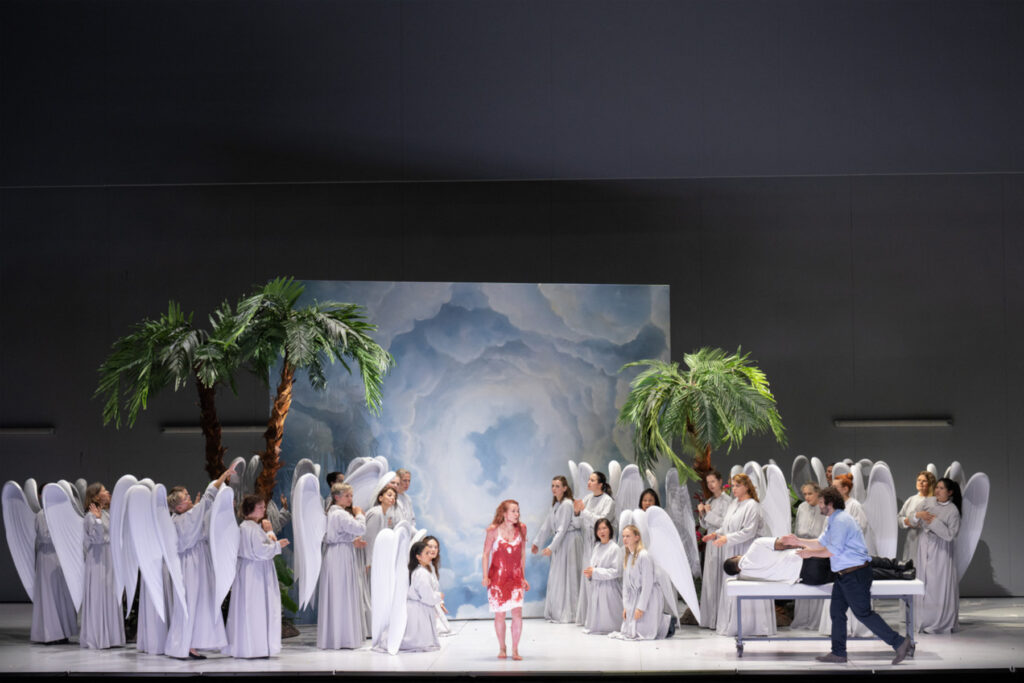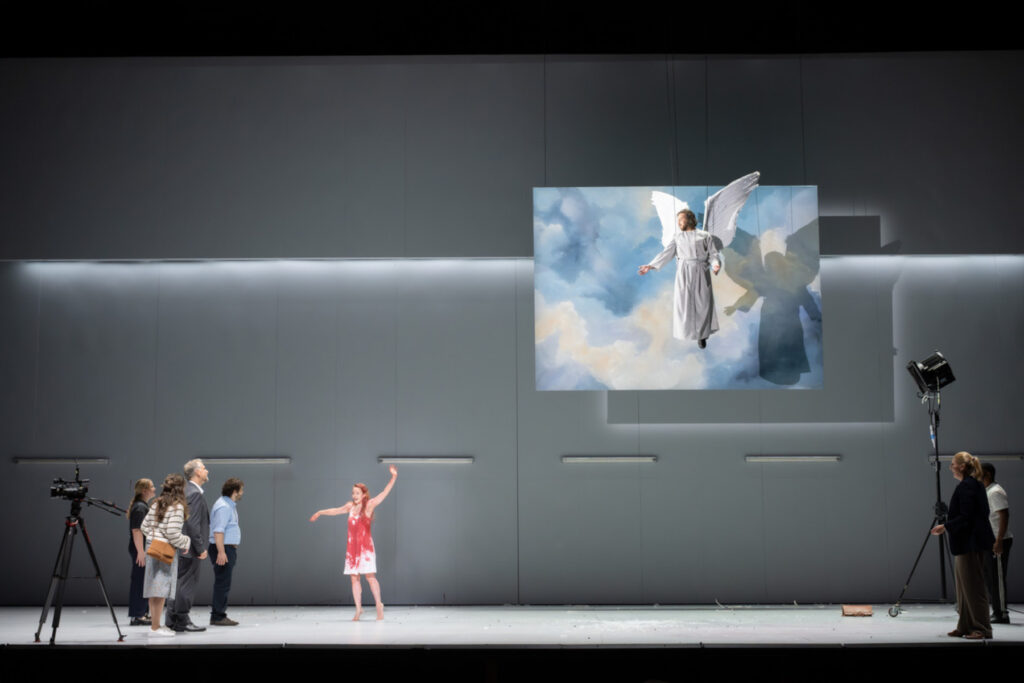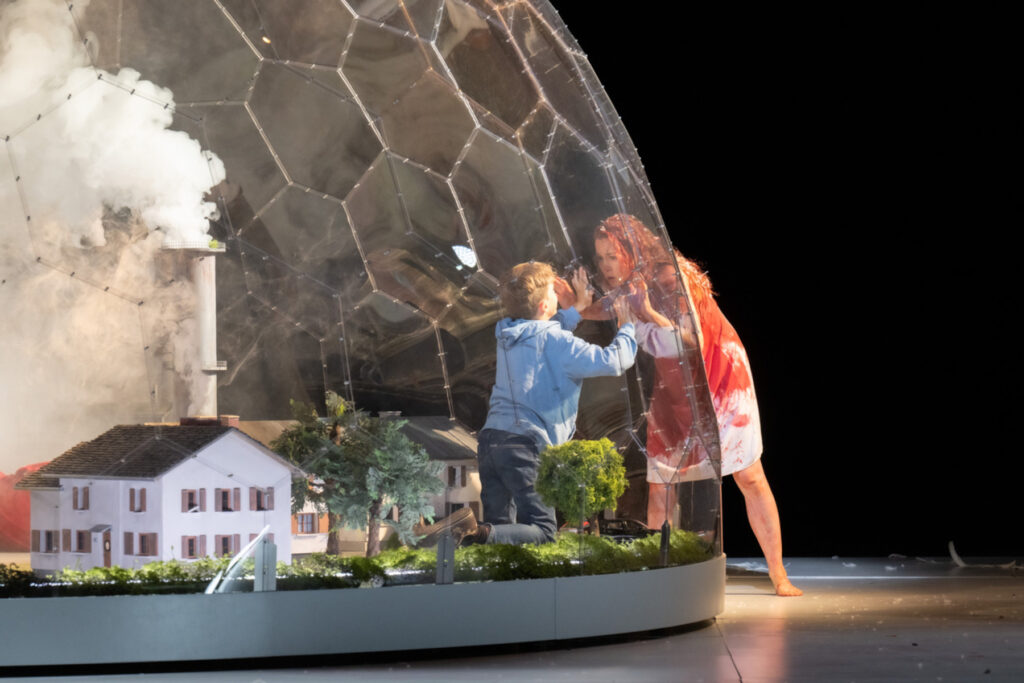Fashions come and go. What might be hailed by one generation is often ridiculed by the next one. That was the fate of Schumann’s secular oratorio Das Paradies und die Peri. It was an unqualified success when premiered in 1843, also rapidly becoming a staple of Victorian choral societies. However, its prevailing sweetness and light together with its heavy sentimentality and moralistic superstructure were definitely out of tune with 20th century preoccupations. Moreover, in the country of its origin, it was tainted by propagandistic misuse by the Nazis, who loved lines like “Denn heilig ist das Blut” (= For blood is holy) to reinforce their Blut-und-Boden philosophy. More recently, though, there has been a revival of interest worldwide by concert promoters and recording labels.
Not all performances of oratorios and semi-sacred works lend themselves to theatrical stagings. Amongst contemporary artists, Peter Sellars and Sir Simon Rattle have collaborated on projects of this kind before. Tobias Kratzer, newly installed Intendant of the Hamburg State Opera, and its equally fresh Generalmusikdirektor Omer Meir Wellber chose to open the new opera season with Schumann’s neglected piece. This was a daring move, especially since Kratzer uses individual voices from within the chorus in order to emphasise a new culture of collectivity and team spirit, without any additional starry soloists and without making the more obvious choice of a big operatic work. Das Paradies und die Peri is by no means an opera manqué, though in the vocal solos and quartets, recitatives and significant choruses plus a sort of heroine as a title figure it has many of the trappings of one.

The libretto derives from a German translation of a verse epic by the Irish writer Thomas More entitled Lalla Rookh, which in turn makes use of Persian mythology. In it, a peri is the offspring of a fallen angel and a mortal. This one has been cast out of paradise (itself an original Persian term) for an unspecified misstep, but a promise has been held out that if she can return to the pearly gates with an example of what is dearest to the Creator, she will be granted re-entry. She makes two unsuccessful attempts at complying, flying first to India to bring back a drop of blood from a hero killed in battle, then to Egypt where she gathers up the last sigh of a Maiden who refuses to leave her plague-stricken lover, only to succeed in her third attempt in Syria where she finds the tear of a sinner expressed in repentance at the sight of a praying child.
Kratzer uses two key lines from the final Chorus of the Blessed Spirits, “Sei uns willkommen” and “Sei uns gegrüsst”, as an invitation both to embrace the audience but also to seek their active involvement. To this end the word “Willkommen” is displayed on a projection screen at the back of the stage, even before the work begins, and the results of a roving camera show close-ups of individual characters but also, crucially, audience reactions throughout the performance. On the opening night these included looks of intense concentration, puzzlement and consternation as one wife sees the video image of her husband (who has nodded off) now visible on the screen to everybody else in the audience. This is one novel way to focus on participation.

What Kratzer also does, and this is the really clever bit, is to view the three parts of the work as paradigms of our current earthly existence. The first part is all about strife and war – with obvious links to the Middle East via the original text – and the staging initially sees chorus members marching on from left and right, dressed like present-day commuters, fighting to get to work, involved in physical confrontations with others before everything degenerates into all-out combat, at the end of which the stage is strewn with bodies, while the floor and walls are streaked with their blood. The second part is entirely cogent and in its implications chilling. We are back in the time of the Coronavirus, the walls illuminated with clinical strip lighting; the stage is dominated by isolation tents; almost everybody is kitted out in personal protective equipment; a Maiden dressed in a black T-shirt bearing the word Nirvana dies a kind of Liebestod after fighting her way through to her betrothed, the Young Man, who in vain tries to warn her of the dangers of viral transmission, “A breath from me brings death to thee”. Again and again scenic representation of the text opens up worrying associations with the present. For the final part we enter the world of the Eden Project, with a large plastic dome inside which children are seen playing until smoke from chimneys engulfs them all with pollution. At this point the screen also picks out an elderly male in the audience whose eyes fill with tears at the sight of the coming generation having to battle with contagion and destruction. Kratzer’s third focus, following war and pandemic, is now on the need for empathy, directed at those already suffering hardship through manifest climate change, but also extending to the simple worry about the kind of environment in which our descendants will have to live. Kratzer’s message is an entirely dialectical one: he gets his peri to leave the stage and enter the auditorium, balancing along several rows of the stalls, as if to question whether the paradise which many strive to attain is worth all the effort. It was Bertolt Brecht who taught that we needed to move away from traditional concepts of kulinarisches Theater, where music and words are merely seen as a form of entertainment, towards a world in which audiences are required to do some active thinking as a response to what they see and hear.

The major role in this work is that of the titled Peri, first seen lying prostrate and lifeless on stage amidst a small nest of torn wings even before the opening prelude, later interacting on an almost constant basis with the other protagonists, having a bucket of blood poured over her at the end of Part One, and at the very end changing from her angel’s costume into the dark garb of the chorus members. Throughout Vera-Lotte Boecker was a credible angelic spirit, agile and flexible in expression. Hers is not a big soprano voice, but it is fresh-toned with a secure top extending to a final high C, occasionally just a little too tremulous. There is a part for an alto, here very well taken by Annika Schlicht, with a number of solos in which the narrative is taken forward. Of the other female singers, Eliza Boom as the soprano Maiden and the mezzo of Kady Evanyshyn made solid contributions.
As in so many sacred works, the main role of narrator is given over to a tenor, and here Kai Kluge made a very strong impression. He sat frequently at a table with a laptop in front of him, documenting proceedings as it were as well as directing video footage, and the richness in his lower register as well as the ringing tones he summoned up to describe the peri soaring above the skies at the start of Part 3 were particular highlights. Christoph Pohl’s firm and focused baritone lent a heroic quality to his role as the war hero Gazna in Part 1. No less authoritative were the collective voices of the Hamburg State Opera Chorus, trained by Alice Meregaglia, whose impeccable diction in the varying guise of the Chorus of Angels, Chorus of the Nile Spirits and the concluding Chorus of the Blessed Spirits added persuasive force to their narrative contributions. The role of the bearded Angel was sung by the Russian counter-tenor Ivan Borodulin. I was not persuaded that this was a happy choice, since this character needs to exude natural authority through the pitch of the voice.
As a composer of large-scale pieces, Schumann has often been criticised, largely because he fails to conform, in the opinion of certain musicologists and critics, to more traditional expectations. The density of the middle instrumental voices in this work, however, reveals a rich complexity of texture. Omer Meir Wellber was extremely good at delivering long flowing melodic lines, often taken with an energising briskness; again and again I noted the deep and dark colouring that he drew from his lower strings. This was especially noteworthy in Part 2, just after intense sounds of anguish came from high-lying woodwind to mark the death of the Young Man. Elsewhere, the exotically pictorial as well as the grandeur of the orchestral writing were much in evidence, not least in a series of tantalising pre-echoes of the composer’s Second Symphony.
New brooms tend to sweep clean, it is said. In this opening production for Hamburg State Opera, Kratzer has demonstrated an engaging ability to think outside the box, to offer an audience an entirely novel participatory experience, and above all to stake out a claim for believing that a scenic representation of a 19th century secular oratorio can make perfect sense, even and especially in 2025. Wellber, too, has made an impressive start to his tenure as Generalmusikdirektor, and a very nice touch was seeing him bring the entire members of his orchestra onto the stage to take a separate curtain call.
Alexander Hall
Schumann: Das Paradies und die Peri
Oratorio for soloists, chorus and orchestra in three parts
Libretto by Emil Flechsig after Lalla Rookh by Thomas Moore (1779-1852)
Cast and production staff:
Peri – Vera-Lotte Boecker; Angel – Ivan Borodulin; Young Man – Eric Lunga Hallam;
Eliza Boom (soprano); Kady Evanyshyn (mezzo-soprano); Annika Schlicht (contralto); Kai Kluge (tenor); Christoph Pohl (baritone);
Chorus and Orchestra of Hamburg State Opera; conductor – Omer Meir Wellber
Director – Tobias Kratzer; Set Designer and Costumes – Rainer Sellmaier; Video – Manuel Braun; Lighting – Michael Bauer; Chorus Director – Alice Meregaglia; Dramaturgy – Christopher Warmuth
Hamburg State Opera, 27 September 2025
Further performances until 1 November
Top image: Kai Kluge as Narrator, Ivan Borodulin as the Angel, Vera-Lotte Boecker as the Peri
All photos © Monika Rittershaus